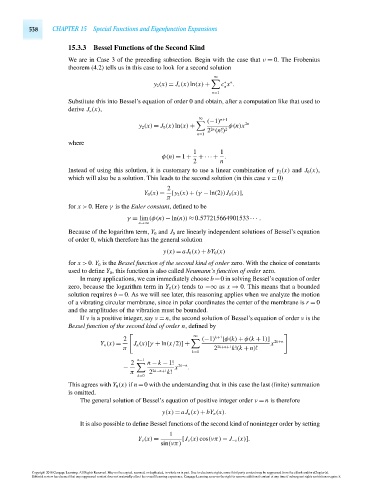Page 558 - Advanced_Engineering_Mathematics o'neil
P. 558
538 CHAPTER 15 Special Functions and Eigenfunction Expansions
15.3.3 Bessel Functions of the Second Kind
We are in Case 3 of the preceding subsection. Begin with the case that ν = 0. The Frobenius
theorem (4.2) tells us in this case to look for a second solution
∞
n
∗
y 2 (x) = J ν (x)ln(x) + c x .
n
n=1
Substitute this into Bessel’s equation of order 0 and obtain, after a computation like that used to
derive J ν (x),
∞ n+1
(−1)
y 2 (x) = J 0 (x)ln(x) + φ(n)x 2n
2 (n!) 2
2n
n=1
where
1 1
φ(n) = 1 + + ··· + .
2 n
Instead of using this solution, it is customary to use a linear combination of y 2 (x) and J 0 (x),
which will also be a solution. This leads to the second solution (in this case ν = 0)
2
Y 0 (x) = [y 2 (x) + (γ − ln(2))J 0 (x)],
π
for x > 0. Here γ is the Euler constant, defined to be
γ = lim(φ(n) − ln(n)) ≈ 0.577215664901533··· .
n→∞
Because of the logarithm term, Y 0 and J 0 are linearly independent solutions of Bessel’s equation
of order 0, which therefore has the general solution
y(x) = aJ 0 (x) + bY 0 (x)
for x > 0. Y 0 is the Bessel function of the second kind of order zero. With the choice of constants
used to define Y 0 , this function is also called Neumann’s function of order zero.
In many applications, we can immediately choose b=0 in solving Bessel’s equation of order
zero, because the logarithm term in Y 0 (x) tends to −∞ as x → 0. This means that a bounded
solution requires b = 0. As we will see later, this reasoning applies when we analyze the motion
of a vibrating circular membrane, since in polar coordinates the center of the membrane is r = 0
and the amplitudes of the vibration must be bounded.
If ν is a positive integer, say ν = n, the second solution of Bessel’s equation of order ν is the
Bessel function of the second kind of order n, defined by
∞ k+1
2 (−1) [φ(k) + φ(k + 1)] 2k+n
Y n (x) = J n (x)[γ + ln(x/2)]+ x
π 2 2k+n+1 k!(k + n)!
k=1
n−1
2 n − k − 1!
− x 2k−n .
π 2 2k−n+1 k!
k=0
This agrees with Y 0 (x) if n =0 with the understanding that in this case the last (finite) summation
is omitted.
The general solution of Bessel’s equation of positive integer order ν = n is therefore
y(x) = aJ n (x) + bY n (x).
It is also possible to define Bessel functions of the second kind of noninteger order by setting
1
Y ν (x) = [J ν (x)cos(νπ) − J −ν (x)].
sin(νπ)
Copyright 2010 Cengage Learning. All Rights Reserved. May not be copied, scanned, or duplicated, in whole or in part. Due to electronic rights, some third party content may be suppressed from the eBook and/or eChapter(s).
Editorial review has deemed that any suppressed content does not materially affect the overall learning experience. Cengage Learning reserves the right to remove additional content at any time if subsequent rights restrictions require it.
October 14, 2010 15:20 THM/NEIL Page-538 27410_15_ch15_p505-562

